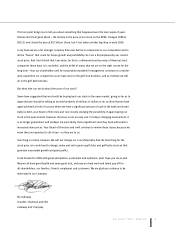Callaway 1999 Annual Report Download - page 21
Download and view the complete annual report
Please find page 21 of the 1999 Callaway annual report below. You can navigate through the pages in the report by either clicking on the pages listed below, or by using the keyword search tool below to find specific information within the annual report.
19CALLAWAY GOLF COMPANY
overhead expenses, including those associated with Callaway
Golf Ball Company and Odyssey’s putter operations.
Charges of $54.2million were recorded in the fourth
quarter of 1998 related to the Company’s cost reduction
actions (see “Restructuring” below). These charges were pri-
marily composed of $28.7million for asset impairments,
excess lease costs, and costs to exit various non-core business
activities, including venues, new player development, interac-
tive golf and publishing, $13.8million for impairment of assets
due to the consolidation of continuing operations and $11.7
million for employee separation costs.
Other income decreased to $3.9million in 1998 from $4.6
million in 1997. This decrease was due to a decrease in inter-
est income resulting from lower cash balances during 1998
versus 1997 and losses on dispositions of assets in 1998. This
decrease was partially offset by net gains on foreign currency
transactions in 1998 of $1.6million, as compared with net
losses in 1997 of $0.9million.
Interest expense increased to $2.7million in 1998 result-
ing from draws on the Company’s line of credit. The line of
credit was not used during 1997.
LIQUIDITY AND CAPITAL RESOURCES
At December 31, 1999, cash and cash equivalents increased to
$112.6million from $45.6million at December 31, 1998. For
the year ended December 31, 1999, cash provided by opera-
tions of $166.3million was partially offset by cash used in
investing activities of $53.5million and cash used in financing
activities of $45.9million. Cash flows used in investing activi-
ties resulted from capital expenditures, primarily associated
with the ramp-up of golf ball operations and deferred purchase
acquisition payments, partially offset by proceeds from the
sale of fixed assets. Of the capital expenditures for 1999,
$50.0million were sold and leased back pursuant to terms of
an equipment financing and lease agreement (see Note 4to
the Consolidated Financial Statements). Cash flows used in
financing activities are primarily due to the repayment of loan
advances and dividends paid, partially offset by proceeds from
an equipment financing agreement (see Note 4to the
Consolidated Financial Statements) and the issuance of
Common Stock.
The Company’s principal source of liquidity, both on a
short-term and long-term basis, has been cash flow provided
by operations and the Company’s credit facilities. The
Company expects this trend to continue even though sales
increased only slightly in 1999 and the Company does not
foresee any significant improvement in sales during the near
term. On February 12, 1999, the Company consummated the
amendment of its line of credit to increase the revolving credit
facility to up to $120.0million (the “Amended Credit
Agreement”) and entered into an $80.0million accounts
receivable securitization facility (the “Accounts Receivable
Facility”) (see Notes 4and 5to the Consolidated Financial
Statements). During the first quarter of 1999, the Company
utilized its Accounts Receivable Facility and borrowed against
its line of credit under the Amended Credit Agreement to fund
operations and finance capital expenditures. At December 31,
1999, the Company had repaid the outstanding balance of the
Amended Credit Agreement with cash flow from operations
and had $115.7million available, net of outstanding letters of
credit, under this credit facility, subject to meeting certain
availability requirements under a borrowing base formula and
other limitations. Also at December 31, 1999, there were no
advances under the Accounts Receivable Facility, leaving up to
$80.0million available under this facility. Further, in the third
and fourth quarters of 1999, the Company converted its note
payable under the Finance Agreement to an operating lease
(see Note 4to the Consolidated Financial Statements).
As a result of the implementation of its plan to improve
operating efficiencies (see “Restructuring” below), the
Company incurred charges of $54.2million in the fourth quar-
ter of 1998. Of these charges, $25.5million were estimated to
be non-cash. Since the adoption of this restructuring plan in
the fourth quarter of 1998, the Company has made cash out-
lays for employee termination costs, contract cancellation
fees, excess lease costs and other expenses totaling $18.8
million, of which $8.5million occurred in 1999. As a result of
the reversal of a portion of certain restructuring reserves total-
ing $8.6million during 1999, due primarily to the assignment
of a lease and the sale of certain of the Company’s buildings at
terms more favorable than estimated, expected future cash
outlays for restructuring activities have been reduced and are
estimated to be $1.4million (see Note 12 to the Consolidated
Financial Statements). This amount is expected to be paid by
July 2000. These cash outlays will be funded by cash flows
from operations and, if necessary, the Company’s credit facili-
ties. If the actual actions taken by the Company differ from the
plans on which these estimates are based, actual losses
recorded and resulting cash outlays made by the Company
could differ significantly.
Although the Company’s golf club operations are mature
and historically have generated cash from operations, the
Company’s golf ball operations are in a developmental stage.
Therefore, the Company does not expect that its golf ball oper-
ations will generate sufficient cash to fund its operations in
2000. However, the Company believes that, based upon its
























